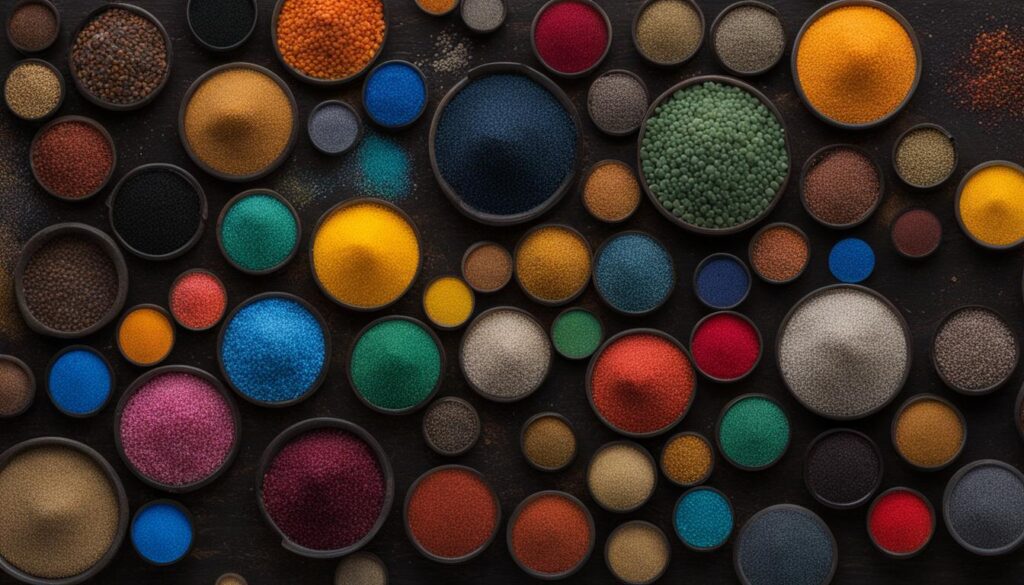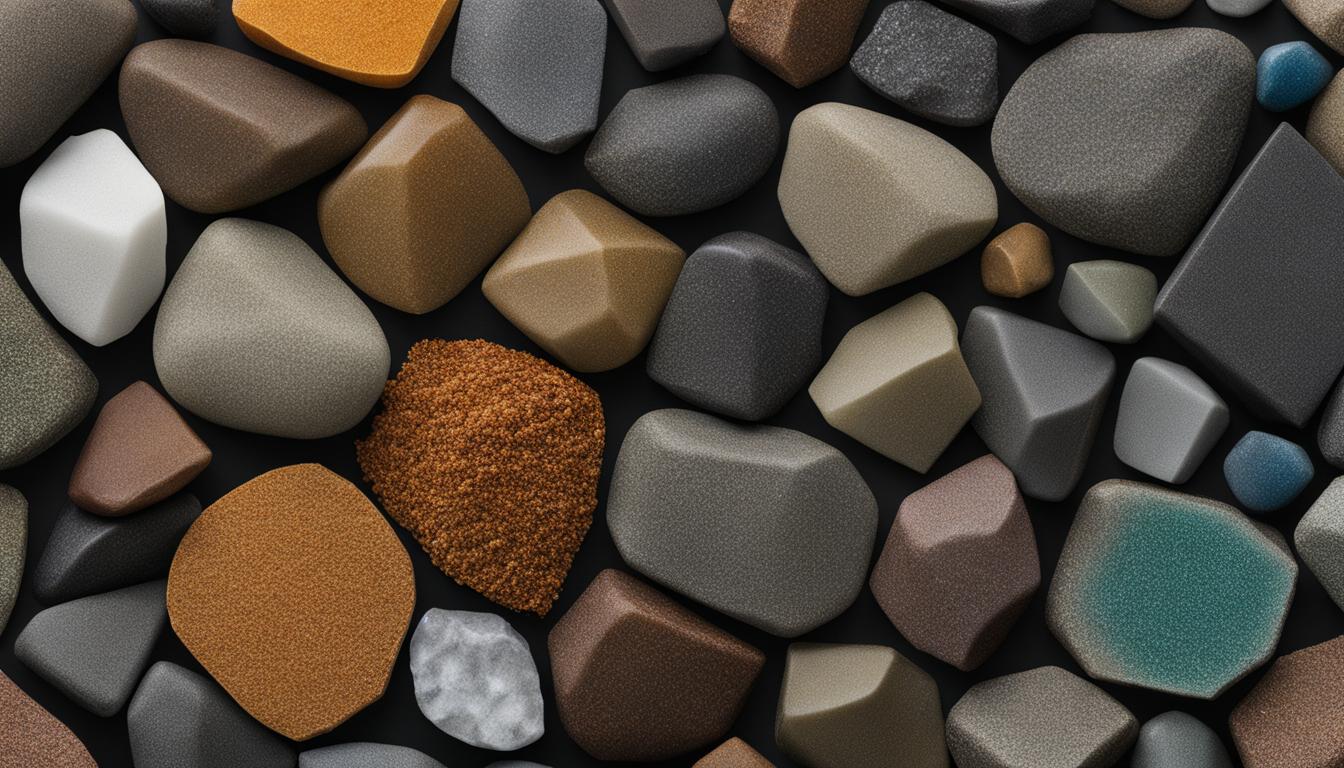This post contains affiliate links.
Have you ever marveled at the smooth, reflective beauty of polished stones? Achieving such a finish is a mix of art and science, with rock tumbling grit being the unseen hero of the process. Whether you’re just embarking on the satisfying journey of rock polishing or seeking to refine your technique, understanding the nuances of rock tumbler grit information is invaluable. Let’s take a deep dive into the realm of rock polishing grit and discover the types of rock tumbler grit, and how to select the best rock tumbler grit for your crafting endeavors.
Selecting the right grit is not just about getting shiny stones. It’s the cornerstone of the transformation process that takes your rough rocks from jagged to jewel-like. With the correct guidance and tools, even novices can achieve professional results. Stick with us, as we unravel the gritty details of rock tumbling, ensuring every step is a stride towards success.
Key Takeaways
- Rock tumbling grit is essential for transforming rough rocks into polished gems.
- Understanding the different types of rock tumbler grit leads to better tumbling outcomes.
- Quality grit contributes to the overall shine and finish of the polished stones.
- Matching the correct grit type and size to your rock’s hardness is crucial.
- Successful rock tumbling relies on a sequential process using a variety of grit stages.
- Purchasing grit from reputable sources enhances your rock tumbling experience.
Understanding Rock Tumbler Grit Basics
Embarking on the rock tumbling journey starts with grasping the essentials of rock tumbler grit. This foundational component determines how well your rocks will be smoothed and polished. Whether you’re a hobbyist or a professional, choosing the right rock tumbler grit is paramount in achieving the perfect finish on your stones.
Definition and Purpose of Rock Tumbler Grit
Rock tumbler grit is the multifaceted material that makes the rock tumbling process possible. It is specifically designed to erode and polish the surface of rocks as they collide within the rotating barrel of your tumbler. The purpose of grit is to methodically shave off the rough edges and surfaces to eventually bring out the rock’s inherent luster. Without it, the tumbling process would be ineffectual.
How Grit Works in the Rock Tumbling Process
When you place rocks in a tumble, they are raw, rough, and ready for transformation. The magic happens when grit is added to the mix. The abrasive quality of the grit, propelled by the relentless motion of the tumbler, slowly softens the imperfections on the rocks’ exteriors. It’s a meticulous path towards polish—a dance of steadfast abrasion and patience.
The Role of Grit Hardness and Particle Size
To each type of rock there is a grit, and matching them is an art form. The hardness of the grit should coincide with the kind of rock you are tumbling, as this will determine how effectively the surfaces are smoothed. Particle size is equally important—the size of the grit will decide whether your rock is merely rounded or brought to a mirror-like finish. It’s a harmony of elements that requires a keen understanding and use of a rock tumbler grit chart.
Now, let’s dive into the practical aspects of grit selection with a handy chart that will guide you in making the best choice for your tumbling needs:
| Grit Size | Particle Size (Microns) | Rocks Type Suitability | Purpose |
|---|---|---|---|
| Coarse (60/90) | 250 – 297 | Hard Stones | Initial Shaping |
| Medium (120/220) | 110 – 165 | Less Hard Stones | Surface Smoothing |
| Pre-polish (500) | 29 – 30 | All Types | Preparing for Final Polish |
| Fine Polish (1500) | 12 – 13 | Soft to Hard Stones | High Gloss Shine |
Armed with the right knowledge and this comprehensive grit chart, you are well on your way to producing beautifully polished stones. Remember, the key to expert tumbling is patience and precision in choosing the right rock tumbler grit for your precious stones.
The Importance of Quality Rough for Tumbling Success
As a devoted rock tumbler, you are likely familiar with the saying “garbage in means garbage out.” This maxim is especially significant in your quest for the perfect polish, where beginning with high-quality rough is essential. Rocks that are porous, bear fractures, or are prone to shedding grains can sabotage your efforts by introducing contaminants that mar the entire batch in the tumbling process.
Finding quality rough is a critical first step for your project, and often, enthusiasts like you wonder where to buy rock tumbler grit that matches the caliber of your materials. The answer lies with specialized rock tumbler grit suppliers, many of whom offer their supplies online. These vendors pride themselves on providing not just materials but also valuable insights based on their personal tumbling experiences.
To aid you in your purchasing decisions, here’s a helpful comparison of features to look for when sourcing your rough:
| Feature | Description | Benefit to Your Tumbling |
|---|---|---|
| Grain Integrity | Rough with a solid internal structure, free from fractures. | Reduces the likelihood of contamination from crumbling grains. |
| Purity | A lack of porous or soft spots that may harbor dirt or absorb liquids. | Ensures a more uniform texture and polish across all of your stones. |
| Size Consistency | Sizing that falls within a narrow range to promote even abrasion. | Facilitates more consistent wear and polish during tumbling. |
| Species Variety | A mix of rock types suitable for your tumbling goals. | Allows for exploration of different polishing outcomes and creativity. |
Remember, a successful tumble starts well before you switch on your machine; it begins the moment you select your raw materials. Invest the time to source your rough from reputable outlets, ensuring that you get the most bang for your buck with quality that shines through every finished piece.
If you find yourself asking “where to buy rock tumbler grit,” starting your search with well-reviewed and experienced rock tumbler grit suppliers will lead you down a path of tumbling excellence. Happy tumbling, and may your stones always emerge with a pleasing polish!
Grain Size and Rock Tumbler Grit Information
Embarking on the journey of rock tumbling requires a nuanced understanding of the materials that will transform simple stones into polished marvels. One critical aspect is grasping how rock tumbler grit sizing plays a pivotal role in shaping, smoothing, and polishing your rocks. The size and type of grit, when aligned with the tumbling stage, determine the effectiveness and the ultimate appearance of your polished stones.
Deciphering Rock Tumbler Grit Sizes
Discovering the secrets behind rock tumbler grit sizes can seem complex, but it’s all about matching the size to the task at hand. A coarser grit size will aggressively remove surface imperfections and shape your rock, preparing it for finer stages, where smaller-sized grit performs the delicate task of polishing and achieving that sought-after shine.
How Grit Size Affects the Tumbling Outcome
The rock polishing grit effects can be dramatic throughout the tumbling process. Consider grit size much like you would sandpaper when smoothing wood. Choose a coarser grit for rapid material removal and progress to increasingly finer grit for a flawless finish. This gradual progression is the key to a phenomenal polish.
Understanding the Grit Grading System
The grit grading system is your roadmap to selecting the right abrasives for your tumbling endeavor. This system, with numerical labels like 60/90 or 120/220, helps identify the grain size and allows rock tumblers to achieve consistency throughout their work. Below is a quick reference guide to commonly used grit sizes and their typical applications within the tumbling process:
| Grit Size | Description | Typical Use |
|---|---|---|
| 60/90 | Coarse | Initial Shaping & Rough Surface Removal |
| 120/220 | Medium | Smoothing Edges & Further Shaping |
| 500 | Fine | Pre-Polishing, Preparing for Final Polish |
| 1000+ | Extra Fine | Final Polishing, Achieving Shine |
By understanding these elements of rock tumbler grit sizing and the subtle yet impactful rock polishing grit effects, you’re well-equipped to embark on your rock tumbling adventure with confidence, aiming for results that are nothing short of spectacular.
Types of Rock Tumbler Grit
Exploring the various rock tumbler grit types is an adventure in precision and patience. As you delve into the world of rock tumbling, you’ll discover that each stage of the process requires a different type of grit to achieve the perfect polish. One of the most popular materials used for grit is silicon carbide—renowned for its durability and effectiveness in grinding down rough edges and smoothing surfaces.
Choosing the right grit is crucial, as it impacts the tumbling efficacy and the quality of polish on your stones. Here’s how to navigate the gritty waters of rock tumbling:
- Coarse Grit: Typically, the tumbling journey begins with a coarse grit to knock off the rough edges and shape the stones.
- Medium Grit: As your stones begin to take shape, a medium grit helps to further smooth the surface, preparing it for finer work.
- Fine Grit: Nearing the end of the journey, fine grit refines the surface, eradicating any remaining scratches and imperfections.
- Polish: In the final stage, a very fine polish gives your stones the gleam and luster that make them truly stand out.
Below are some of the standard rock tumbler grit types to help you understand what you might need:
| Grit Type | Common Uses | Benefits |
|---|---|---|
| Silicon Carbide | Coarse and medium grinding stages | Hard, sharp, and durable for quick edge shaping |
| Aluminum Oxide | Fine grinding and pre-polishing | Long-lasting and reusable for multiple tumbling cycles |
| Cerium Oxide | Final polishing stage | Produces high-luster shine on most stone types |
When you are selecting the proper grit for your project, consider the type of stones you’re working with and the desired finish. Remember that using the correct sequence is as important as the grit choice itself. A uniformly smooth and polished surface is the mark of a successful tumble, which can only be achieved with proper technique and patience.

Now that you’re equipped with the knowledge of the different rock tumbler grit types, you’re on your way to creating beautiful, polished gemstones that reflect your dedication to this timeless craft. Remember to take your time and enjoy the process – the results will surely be worth it!
Rock Tumbler Grit Information: A Beginners’ Must-Know
Embarking on the journey of rock tumbling can be thrilling, especially if you’re aspiring to uncover the natural beauty hidden within rough stones. To transform these stones into polished gems, it’s crucial to have a firm grasp of the best rock tumbler grit and comprehend the specific functions of different grit stages. Here is the essential information to ensure you start on the right path, selecting the apt grit tailored for beginners and mastering the tumbling progression.
Selecting the Right Grit for Your Rock Type
When choosing the right rock tumbler grit for beginners, understanding the Mohs scale of mineral hardness is imperative. Rocks within the 5-7 range typically yield the most success, offering a harmonious balance for polishing without succumbing to grit-induced damage. The correct selection of grit is a cornerstone for avoiding unnecessary wear on softer stones and ensuring harder stones are effectively smoothed.
The Stages of Grit in the Tumbling Process
As you become acquainted with the craft, recognizing the rock tumbler grit stages will guide your expectations and results. The process is a systematic evolution of coarseness, starting with a heavy grit that moves to finer grains as your rocks progress towards perfection. Here’s an outline of how each stage plays its role:
- Coarse Grit: Primarily used for initial shaping and the removal of any jagged edges.
- Medium Grit: This stage smooths deeper scratches left by the coarse grit, preparing the stones for finer polishing.
- Fine Grit: The rocks are now further smoothed, setting the stage for the final shine.
- Polish: This final stage uses the finest grit for achieving that desired lustrous finish.
Calculating the Appropriate Amount of Grit
Accuracy in calculating the right amount of grit not only conserves your supplies but also guarantees that your stones are treated with the necessary attention they deserve. Measure the grit based on manufacturer guidelines and the size of your tumbler barrel to avoid overloading or under-utilizing, both of which could impede the tumbling effectiveness and the longevity of your rocks and equipment.
Embarking on your rock tumbling adventure with a clear understanding of grit types and uses sets the stage for a hobby that’s as rewarding as it is fascinating. Remember, the magic is in the details, and a little knowledge goes a long way. Start with the best practices, and soon you’ll be polishing like a pro.
Essential Tips for Achieving the Best Polished Rocks
Embarking on the journey of rock tumbling is an adventure filled with anticipation and the prospect of transforming the ordinary into the extraordinary. To guide you along this path, integrating a few essential rock polishing tips and a handy rock tumbler grit chart will be instrumental in realizing the full potential of your efforts. Let’s delve into the practices that will elevate your rock tumbling from mere hobby to art form.
“Garbage in Means Garbage Out” Principle
It is a timeless truth that the quality of your starting materials determines the quality of your final product. In the realm of rock tumbling, this principle is paramount. Ensuring that you begin with rocks that are free from fractures and have uniform hardness will set the foundation for a successful tumbling operation. It might be tempting to take shortcuts or settle for less than ideal rough, but remember that patience and discernment at this stage will reward you with shining results later on.
Maintaining Proper Tumbler Balance and Fill Levels
To achieve the symphony of smooth motion and perfect polish, the balance and fill level of your rock tumbler need to hit just the right note. A well-balanced tumbler filled to the optimal level creates a consistent grinding action and ensures that each rock receives its due attention. Adhering to the recommendation of filling your tumbler between half to two-thirds full will facilitate the perfect environment for your rocks to undergo their magnificent transformation.
Preventing Contamination Between Tumbling Stages
Meticulous care between tumbling stages is vital for the pristine outcome of your work. Ensuring that every trace of the previous grit size is removed before moving on to a finer grade is non-negotiable. Any rogue grit can leave unsightly scratches on your rocks, marring the polished surface you’ve worked so hard to achieve. A thorough cleaning of both rocks and the barrel itself is your surest defense against such contamination and your best assurance for success.

As we consider these polishing pearls of wisdom, let’s consult a comprehensive rock tumbler grit chart, which is an indispensable reference for both novices and seasoned enthusiasts alike.
| Stage | Grit Size | Material | Function |
|---|---|---|---|
| 1st – Coarse Grind | 60/90 | Silicon Carbide | Shaping and smoothing rough edges |
| 2nd – Medium Grind | 120/220 | Silicon Carbide | Further refining and preparing for pre-polish |
| 3rd – Fine Grind/Pre-polish | 500 or 600 | Silicon Carbide | Smoothing surface before final polish |
| 4th – Polish | 1200 Aluminum Oxide | Aluminum Oxide/Cerium Oxide | Final polishing to achieve a bright shine |
Remember, with each step forward on the chart, you are one leap closer to perfecting your polished rocks. Whether you are a beginner or an old hand at rock tumbling, revisiting these tips will ensure that your stones emerge from their gritty cocoon with a luster that captures the light and the envy of fellow tumblers. Embark on shaping not just stones, but your skills, as you polish each rock to perfection.
Where to Buy Rock Tumbler Grit and Supplies
Embarking on your rock tumbling journey necessitates finding rock tumbler grit suppliers that cater to all your needs. Knowing where to buy rock tumbler grit and supplies can make the difference between creating good and great polished stones. You’ll want vendors that not only provide a range of grit sizes and types but also share valuable insights into their use.
Many online platforms specialise in lapidary supplies, making it easy and convenient to purchase high-quality grit. Experienced hobbyists often turn to these online suppliers for their consistency and expertise. Below is a guide to help you navigate through your options and ensure you select the best possible materials for your tumbling projects.
| Supplier | Grit Sizes Available | Specialty |
|---|---|---|
| Rocks R Us | 60/90, 120/220, 500, 1000 | Silicon Carbide Grit |
| Lapidary Mart | 80, 220, 400, 600 | Wide variety of Polishing Compounds |
| The Tumbling Times | Coarse to Fine | Bulk Orders and Rock Tumbling Kits |
Before making a purchase, it’s wise to join forums or read reviews to learn from the experiences of seasoned tumblers. Don’t hesitate to reach out to suppliers directly to ask questions about their rock tumbler grit and how it performs with different types of rocks.
Remember, the right supplier doesn’t just sell you grit; they offer support and guidance as you refine your tumbling technique. Invest in quality materials, and your passion for rock tumbling will undoubtedly yield shiny, exquisite results!
The Four-Step Rock Polishing Process Explained
Embarking on the journey of rock tumbling requires an understanding of its core steps, each pivotal to transforming dull stones into polished gems. Your meticulous attention to the best rock polishing process is what can distinguish an ordinary stone from a truly lustrous treasure. We’ll guide you through the established rock tumbling techniques that ensure a show-stopping finish. Remember, patience and precision are your best tools.
Initial Coarse Grind with Coarser Grits
It all starts with a coarse grind, using coarser grits to shape the rocks. Imagine this step as laying the foundation for your masterpiece – it’s where you remove the jagged edges and give your stones a basic form. The coarser grits act as the robust hands of a sculptor, chipping away the unnecessary to reveal the rock’s potential. Your careful monitoring during this phase is crucial to set the tone for the entire polishing sequence.
Smoothing Edges and Removing Scratches in Mid-Steps
With the basic shape established, you then move to the mid-steps of rock polishing steps. It’s here where your stones begin to whisper hints of their final brilliance. Medium grits smooth out the coarse scratches and nicks, blending the contours and refining the stone’s surface. This step acts as a mediator between the aggressive initial shaping and the delicate dance of polishing that follows.
Pre-Polish and Polish Steps for Ultimate Shine
The climax of your endeavor comes with the pre-polish and polish stages. Transitioning to a fine grit, your patience pays off as this step is where the magic happens, bringing out an enviable shine. It’s a process likened to the careful finishing strokes of an artist, ensuring each facet reflects light flawlessly. Your dedication during these final stages is what leads to a magnificent and glistening conclusion to the rock tumbling process.
FAQ
What is rock tumbler grit and why is it important?
Rock tumbler grit is an abrasive material used to smooth and polish rocks in a tumbler. It’s important because it gradually shapes and refines the rocks through a process of grinding and polishing when combined with the tumbling motion.
How does grit work in the rock tumbling process?
In the rock tumbling process, grit works by acting as an abrasive that wears away the rough surfaces and edges of rocks. As the tumbler rotates, the grit particles grind against the rocks, resulting in smoother and more polished stones over time.
What’s the role of grit hardness and particle size in rock tumbling?
Grit hardness and particle size play critical roles in determining how effectively the grit will shape and polish the rocks. Harder grit can work on tougher rocks, while particle size affects the level of abrasiveness, with coarser particles for shaping and finer particles for polishing.
Why is it crucial to start with quality rough materials in rock tumbling?
It’s crucial to start with quality rough materials because the final polish is directly related to the condition of the initial rocks. Poor-quality rough can lead to unsatisfactory results, while high-quality rough can result in beautifully polished stones.
How can you decipher rock tumbler grit sizes?
Rock tumbler grit sizes are deciphered by understanding the grit grading system, which specifies the coarseness or fineness of the grit. Typical grades range from coarse (e.g., 60/90) for initial grinding, to fine (e.g., 500) for polishing.
How does grit size affect the tumbling outcome?
The size of the grit affects both the rate at which the rocks are smoothed and the quality of the finish. Coarse grit sizes remove imperfections and shape the rocks, while fine grit sizes create a polished, shiny surface.
What are the different types of rock tumbler grit available?
The most common type of rock tumbler grit is silicon carbide, but other types include aluminum oxide and ceramics. Each type and size of grit is used for different stages of the tumbling process, from initial shaping to final polishing.
How do you choose the right grit for your rock type?
Choose grit based on the hardness of the rocks you’re tumbling. Rocks that are too soft may disintegrate, while rocks that are too hard may not polish well. A general rule is to use a grit that matches or slightly exceeds the hardness of your rocks.
What are the stages of grit used in the tumbling process?
The tumbling process typically involves four stages of grit: a coarse grit for rough grinding, a medium grit for smoothing, a fine grit for pre-polishing, and a very fine grit or polish for the ultimate shine.
How do you calculate the appropriate amount of grit to use?
To calculate the appropriate amount of grit, fill the tumbler barrel 2/3 to 3/4 full with rocks and then add enough grit to cover the rocks. The actual amount may vary depending on rock size and the manufacturer’s recommendations.
What does “Garbage in means garbage out” mean in rock tumbling?
In rock tumbling, this phrase means that the quality of the final polished stones largely depends on the quality of the initial rough rocks. Poor starting materials will likely result in a lackluster finish, even if all other steps are correctly followed.
How do you prevent contamination between tumbling stages?
To prevent contamination between stages, thoroughly clean the rocks, the barrel, and any other tumbling materials after each stage. Any leftover grit from a previous stage can scratch rocks in subsequent stages, ruining the polish.
Where can you buy rock tumbler grit and supplies?
You can purchase rock tumbler grit and supplies from a variety of online vendors that specialize in lapidary supplies, as well as from some hobby shops. Look for reputable vendors who provide detailed product information and customer support.
What are the four primary steps in the rock polishing process?
The four primary steps are: initial coarse grinding with coarser grits to shape the rocks, medium grinding to smooth and refine the surface, pre-polishing to prepare the stones for the final stage, and the final polishing step where a fine grit or polish gives the stones their luster.
Source Links
- https://rocktumbler.com/tips/rock-tumbler-instructions/
- https://rockhoundresource.com/how-to-tumble-rocks-get-great-results-every-time/
- https://www.abcrafty.com/rock-tumbling-guide/
This post contains affiliate links.

